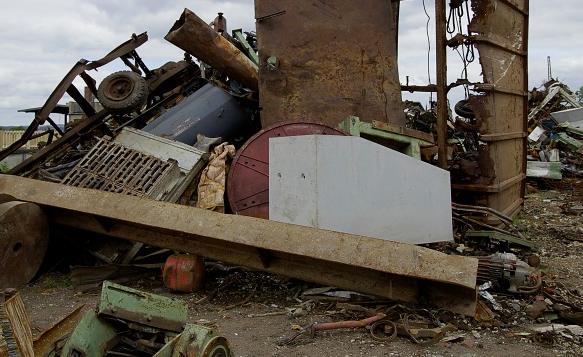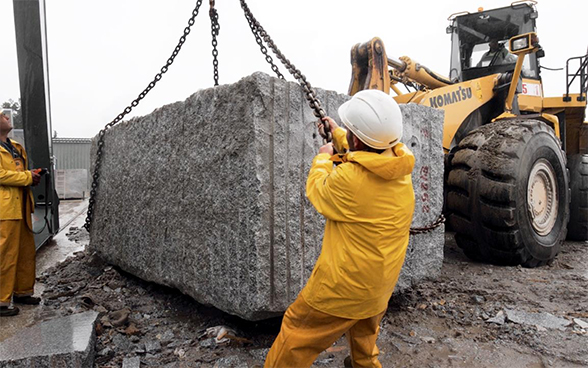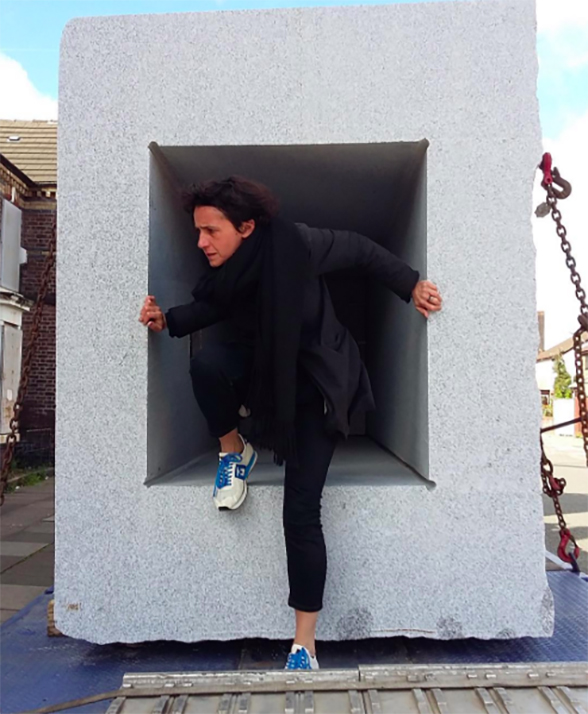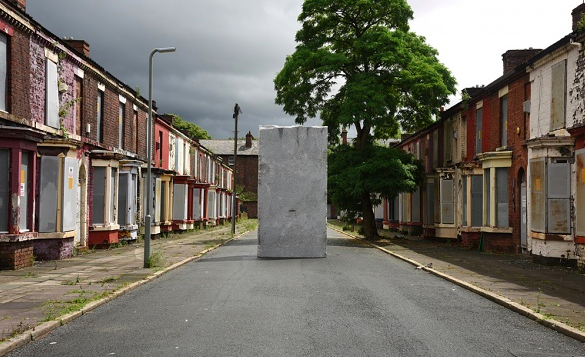From France to Liverpool 8: The Making of Lara Favaretto's Momentary Monument
Posted on 11 October 2016 by Liverpool Biennial
Lara Favaretto, Momentary Monument – The Stone, 2016. Photo: Mark McNulty
Standing 10ft tall and weighing 24 tonnes, Lara Favaretto's towering artwork, Momentary Monument – The Stone, has occupied the centre of Rhilwas Street in Liverpool 8 since it was installed just days before Liverpool Biennial 2016 opened to the public. With the festival now drawing to a close, we look back on its journey.
The piece is part of the Momentary Monuments series, which the Italian artist began in 2005 as a meditation on the temporary nature of all monuments and the impossibility of memorialisation – each work often ending in its own eventual destruction. Previous artworks from the series include a wall that consisted of 36,000 sandbags piled up around the statue of Dante Alighieri in Trento, before finally collapsing in on itself. Another consisted of a temporary marsh in the garden outside of the Arsenale at the 2009 Venice Biennale, which concealed tributes to ‘fugitives’, people who had withdrawn themselves from the public eye.

Lara Favaretto, Momentary Monument IV (Kassel), 2012. Courtesy of the artist and Galleria Franco Noero, photo by Henrik Stromberg
Favaretto’s commission for Liverpool Biennial is a hollow granite boulder that passers-by can drop money into through a slot in its side. As soon as the festival ends, the boulder will be destroyed and the funds donated to a local charity, Asylum Link Merseyside. The organisation is dedicated to assisting asylum seekers and raising public awareness around refugee issues. But how is an artwork of this magnitude made and how did it get here?
The Material
For her Biennial commission, the Turin-based artist chose to work with granite, a material of seeming permanence. It took a great deal of searching to source exactly the right kind, but it was eventually found from a quarry in France.

Photo: Rob Battersby
Cut to Size
To carve such a large piece of granite to Favaretto’s specific design required great skill, and it took a long time to find a suitable stonemasonry. Eventually a site was located in Ireland and the stone transported there by ferry.

Photo: Rob Battersby
From Ireland to Liverpool
Once the cutting process was complete, the stone began the final leg of its journey: travelling again by boat to the Liverpool docks, followed by lorry to Liverpool’s Welsh Streets. Favaretto chose the location after several visits to Liverpool and a great deal of consideration. Once part of a thriving, busy community, Rhilwas Street is now no longer inhabited after the area was ear-marked for demolition and redevelopment in 2004. The placement of the stone here is a nod to the themes of the wider Momentary Monuments series: impermanence and the eventual passing of all things.

Photo: Rob Battersby
Installation
Accompanied by her assistant, Favaretto travelled from her home in Turin to Liverpool to oversee the installation of the piece. Once the stone arrived on site early in the morning, it was lifted by crane and positioned in its final spot under Favaretto’s guidance, along with the help of the Biennial curators. The whole process took one day in total, and was completed just less than a week before the festival opened to the public.

Photo: @franceco.manacorda on Instagram
Nothing Lasts
The destruction of the stone at the end of the Biennial is an important part of the overall piece. The material will be dispersed and Momentary Monument – The Stone will continue to exist only in people’s memories and through its documentation.
Visit Momentary Monument – The Stone any time, day or night, before 16 October 2016.
Liverpool Biennial
55 New Bird Street
Liverpool L1 0BW
- T +44 (0)151 709 7444
- info@biennial.com
Liverpool Biennial is funded by
Founding Supporter
James Moores
